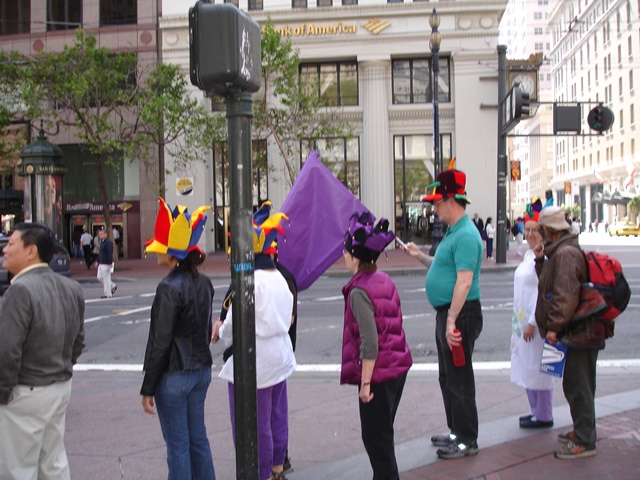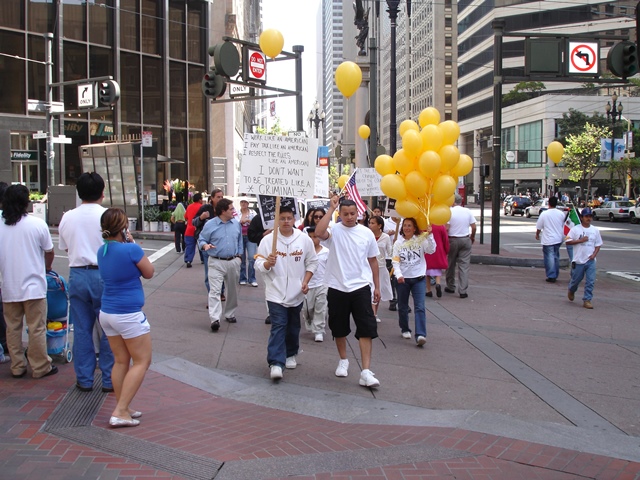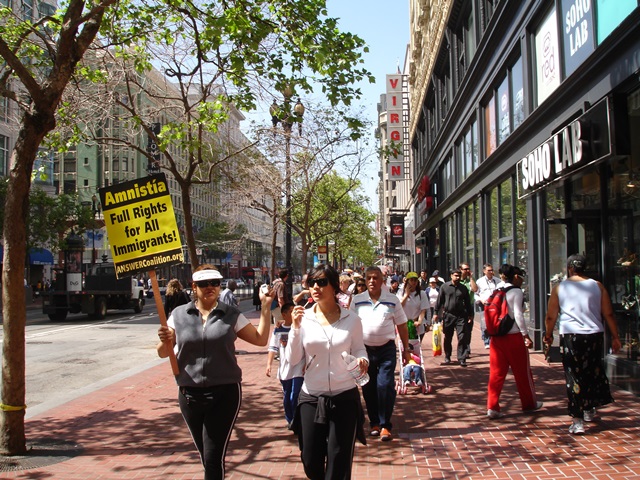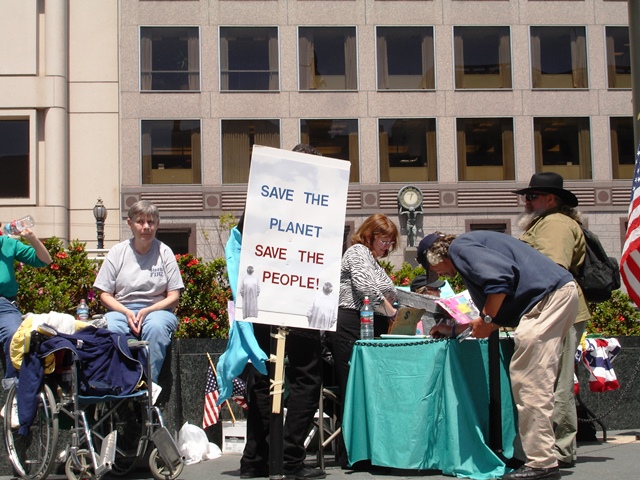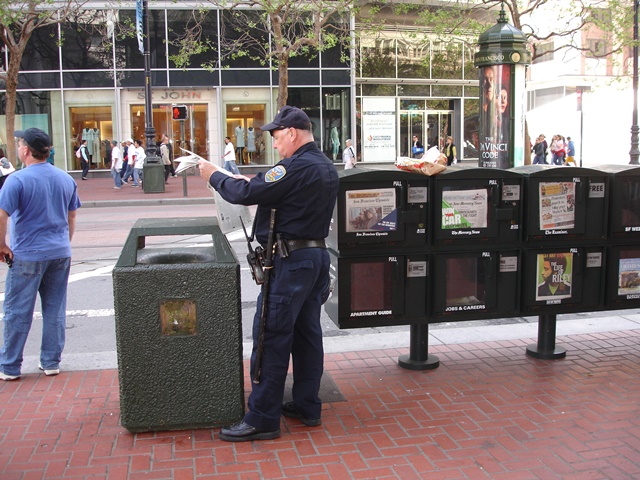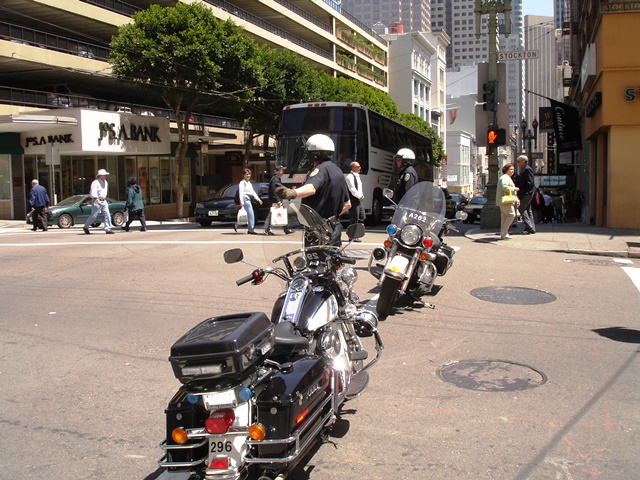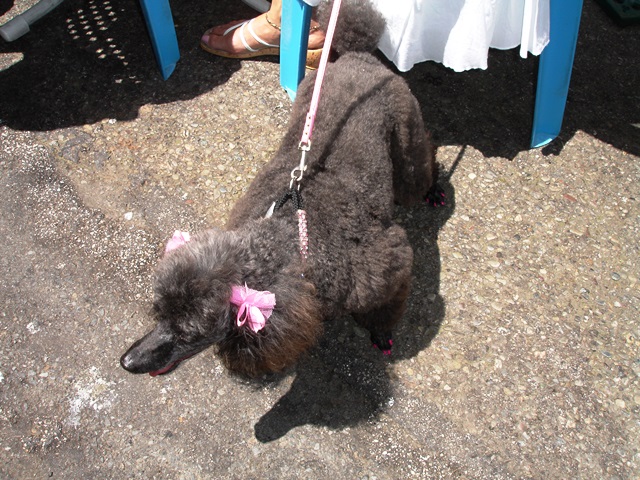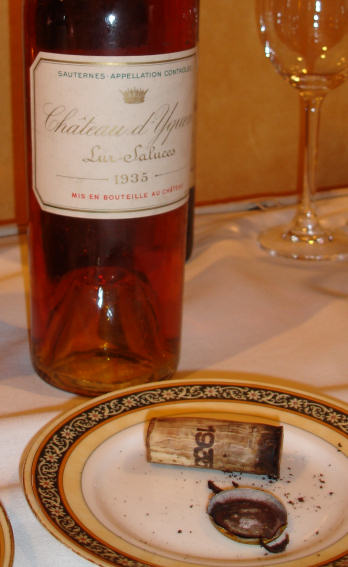 Sa délicatesse est exemplaire.
Sa délicatesse est exemplaire.
Golden Gate, gris ou rouge ? mardi, 2 mai 2006
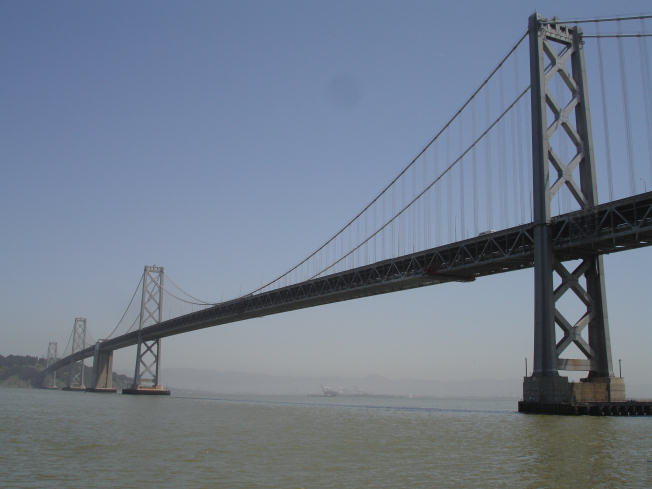 On est habitué à le voir rouge.
On est habitué à le voir rouge.
Mais je ne le trouve pas mal du tout en gris.
Et vous ?
70 Californian wines drunk with passionate members of a forum lundi, 1 mai 2006
My trip to USA has been organised in a much unexpected way. Bipin Desai organises two meals with wines of two producers, Trimbach and Lynch Bages. I would not necessarily fly 6,000 miles to taste these two wines that I can easily drink if I visit the properties, but as Bipin had been kind enough to invite me for the huge tastings of 38 years of Montrose and 22 years of Pichon Comtesse, I decided to say yes. I announced on the forum of Robert Parker that I would come to California, and immediately I received several proposals for dinners. So, seeing how enthusiast and generous people that I know only on my screen would be, people building very consistent programs, I decided to say yes to some, the only refusals being for my health, as this week will see me drinking a lot of wines.
I will describe my trip more like a diary than like wine tasting notes, but as wine is the main theme, wine will be largely concerned. To determine the wines that I would bring has not been so easy, as I wanted to adapt my wines to the general level of what would be brought, not under, not too above. I took the following wines in my cellar : Grands Echézeaux Domaine de la Romanée Conti 1974, that I wanted to taste with Californian wines of the same age, Pétrus 1959 will be brought for a dinner on which I know nothing, but organised by a man who is known to make great dinners, Potensac 1955 will be a birthday present for a friend born 51 years ago, Yquem 1953, Pichon Comtesse 1945, Yquem 1935 for some dinners. The last wine is a Canarian wine of 1828, is to make a surprise to Bipin, to thank him. I had wanted to bring for friends a Cyprus wine 1845, but due to moves from my cellar to my home, the wax had broken and there was a linkage which obliged me to keep it home. It will no be lost. French amateurs exist.
The direct trip is an eleven hours flight. I am sitting next to a man compared to whom George Foreman would be a feather weight. It makes the trip even longer. A film of Harry Potter shows the evidence that there is no limit to stupidity in using wonderful techniques for primitive emotions. To take a plane is a school for serenity. You spend your time in queues, you wait for an improbable progress in your queue, you are considered as if you were the most dangerous gangster on earth, and I must say that Hitchcock is a small kid pretending to create suspense, compared to the unparalleled stress when the rolling luggage provider stops its move when everyone has got his bag except me. The staff in charge of luggage is largely better than Mary Higgins Clark or every other best seller’s authors.
A limousine is waiting for me, which is a sign of civilisation. The Campton Place hotel is nice. This time, no queue on the registration desk. I will sleep with many stops for 16 hours, not knowing at any moment on which time table I am programmed. After a solid XXL breakfast, I go walking in town. On May 1st, in USA, people work, when in France every pretext is good to stop working. But this day is a day of demonstration about the acceptance of illegal immigration. Some groups are formed, with the obvious pleasure to be together, smiling, singing, dancing sometimes, and delivering messages written in a way that at a small distance you cannot read any. I was in the middle of this small crowd, policemen had closed some streets. When I read the next days what was said about the importance of the demonstration, I was very astonished, because all what I had seen was extremely light when compared to what newspapers mentioned. What amazes me is the variety of faces, of people, of poverty in the streets of American cities. Paris was known for its “clochards”. I have seen today many more than in one year in Paris. One young thirty years white broke was scratching his leg of a very gray colour which has certainly never been in contact with water for the last decade. I find a café in a pedestrian street where I eat on a table outside. A woman indefinitely lifted comes with a dark dog with pink ribbons around the ears. She is exactly how American women of an indeterminated age are caricatured. The man who plays accordion goes from the Beatles to the Third Man, and from Edith Piaf to Freddy Mercury with the same constructed smile.
Ken comes to take me to Jack Falstaff, a restaurant with an external decoration of a building made of concrete after the Armageddon attack. We are not far from the Giants Stadium, and as our room is in open air inside the building, the noise of traffic could be disturbing. But in fact, passionate as we were, we will listen to nothing. I begin to open some bottles by 4 pm, as many have already been brought. I open some of them and I receive a major help by Mark, who will open a lot of them. We put all the bottles in a row, with the corks and capsules associated to them. Very frightened, I see many people coming with more than twice as many bottles as we are. Many of them bring their Riedels.
Ken is so happy with this event that he opens a half Krug Grande Cuvée, very agreeable as we work so hard to open all the bottles. Everybody is there and by 7 pm precisely, Christine, who organised everything so well declare that the tasting is opened. I say a few words to thank everyone for their generosity and I give advice on the way to approach old wines which are not familiar with many members of our group. I sit at my place, and Paul will make a very long speech to present his fabulous bottle, the Martin Ray 1953 from Saratoga, Cabernet Sauvignon. Then, when his speech is over, the glasses in front of me are poured by an army of friends wanting that I try this and that. And I think that I will never be able to remember all what is poured to me. But I am not the only one to be so generously provided with wines. All around me everyone exchanges their wines with the others. The atmosphere is highly friendly. I say to Christine that I am afraid that so many wines are drunk when the dinner has not yet begun. And I am right, as a soup will help a lot the wines, mainly the whites, to become greater. So many wines are poured in my glasses that I am unable to say which one it is and when someone asks me : “did you like it”, I say yes, not knowing which one it was. But of course, I remember some of them.
Some whites have aged very differently. A Chardonnay 1977 Stony Hill Napa Valley pleases me a lot, with a nice Burgundy smell, sweeter in mouth than Burgundy.
In all the wines that we have drunk, I do not see a real difference of aging between French and Californian wines. The proportion seems to be the same of tired wines. The Gamay 1970 Joseph Swan has surprised everyone as it was extremely young and expressive. I did not notice corked wines, and the ones who were slightly corked did not show it in mouth.
The wines that I have particularly appreciated are : Heitz cellar 1968, Ridge Montebello 1970, Beaulieu 1966, Inglenook 1965.
I have found my Grands Echézeaux Domaine de la Romanée Conti 1974 to be rather tired after the travel and the heat in different steps of the trip. But its cork was largely tired when I found unusually young the cork of the “old” Californian wines, nearly not wet with wine, just a small circle being highly invaded by an heavy sediment of a black colour.
I have loved the Yquem 1953, a very nice, subtle and elegant Yquem (I saw that many friends having not the same perspective on Yquem did not probably approach it as I did), and I saw that my American friends are real kids. While I was sipping with pleasure the Yquem, served at last, to be the last perfume of the night, I saw many of them coming back to the reds!!!!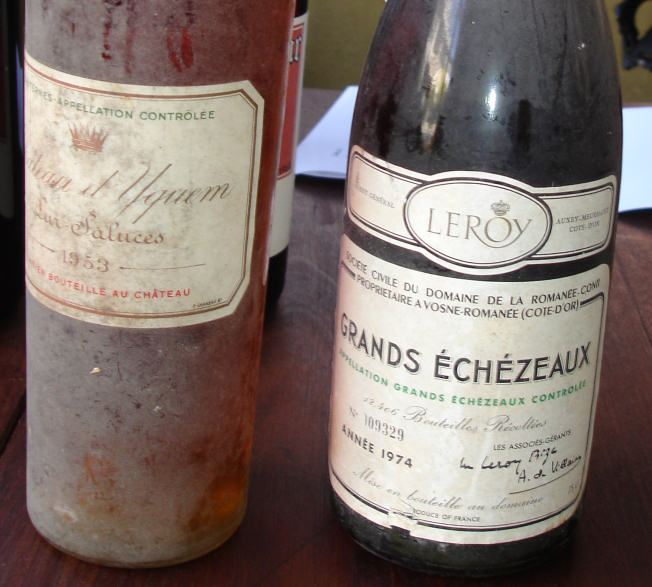
Within the group, I saw a man whose face was known to me. He had attended already two of my dinners !
Everyone has been aware that Californian wines can age and that the slow oxygenation helped a lot the wines to perform precisely.
For me the two stars of the night are the two oldest, which will not surprise anyone : the Martin Ray 1953 was for me the most impressive red of the dinner, and the Yquem 1953 is a Yquem which is in the direct line of what Yquem should be.
The food has been extremely adequate; the service of the staff of Falstaff was highly efficient. I have really enjoyed being the excuse for this meeting and to help to see that Californian wines age well when one is prepared to drink them as they are.
And when I see their potential to age, I would really think that it is probably not necessary to push the young wines to their limits in taste, as there is a certainty that they will age wonderfully, keeping a significant harmony and subtlety.
Thanks to all for their generosity, thanks to Christine to have so well managed the event, and thanks to all the friends for their so passionate attitude towards nice wines.
Great tasting of old Californian wines in San Francisco lundi, 1 mai 2006
After sixteen hours of restful sleep, it’s time to revisit San Francisco. On the first of May, in the USA, we work, but we also manifest. It is a day of parades for the regularization of illegal immigration. Here, it is gentle, folkloric. Small groups are formed of the same tendency of skin, behind placards illegible to five meters. The important thing is to show up. The policemen barred the streets to let those meager groups express themselves with smiles. Being very close to this agitation since the epicenter is at Market Street and Union Square where I am wandering, I will have an impression contrary to what I will read the next day in the newspapers, where one evokes the most important parades since the Protest against the war in Vietnam. Who is right ? The passing tourist? The journalist ? Probably the newspaper, since it is written.
I am pleased when strolling through the American streets, which are living galleries of portraits. All that one can imagine more typified, marked, even deformed, walks. The socially excluded are shown. A young alcohol-eating white boy scratches his gray legs that have not seen water for ten years. A policeman on duty took up his position to read his newspaper on a firemen post by engulfing a huge sandwich. At the lunch break young executives go into tiny stalls hideously decorated, nibbling obese foods. Conversely, ladies with multiple lifted faces walk dogs wrapped in rose clothes in the places where it is necessary to be seen. I would dream of having a concealed camera to capture these incredible faces of creative beauty. One cannot frankly say of this multicolored crowd that it is « fashion addict » as it is multiforme. I go shopping, I notice that the « cable car » that I had used more than forty years ago has not changed, I exhausted myself to instinctively seek Lombard Street, that serpentine street that I have already trampled from bottom to top and from top to bottom. A pleasant outdoor restaurant in a pedestrian street tempts me. I lunch in this little bistro to the sound of an accordionist who passes from the Beatles to the Third Man and from Freddy Mercury to Edith Piaf with the same forced smile.
Ken picks me up at my hotel and we go to Jack Falsatff, a restaurant that has decided to show up as a bunker or an abandoned building after the Armageddon invasion. In this place not far from the Giants Stadium that has match tonight (they will lose), we will be outdoors. The sirens, the rumbling trucks will enhance our dinner without disturbing it. I come to open the bottles at 4 pm, and many guests are there to see « the Audouze method » for opening and oxygenation. According to a well-American tradition, the 28 we have brought nearly 70 different wines. The particularity is that these are wines that are hardly found in these tastings: Californian wines before 1980. When this group had invited me to join them, I was asked to propose a theme. I chose the ancient Californian wines, without assuming that the prohibition broke a chain of continuity. There is practically no old wine from before 1960.
The oldest wine of this evening will be a Martin Ray 1953 from Saratoga, Cabernet Sauvignon, a real relic long presented by Paul who brought it and broods it as his child. This delicious wine, with the flavors reminiscent of the rather complex burgundy, pleased me enormously.
The bottles are opened long in advance. Also, with a legitimate pride, Ken opens a half-bottle of Krug Grande Cuvée, very tasty, simple of message, promising of the great event that is being built. New guests arrive, bringing Riedel glasses and wines in their arms. At 7 pm we went to the table. I take the floor to thank the organizers of which Christine, the group’s effective leader, and I give some advice on the tasting of old wines, which will be as unknown for them as for me, because some wines do not come from the cellar of the participants. Quite often, they have done research to find these wines. As soon as we are seated, the glasses fill at a mad speed, for each wants to make others try his contributions. I’m a little worried that we drink so many wines while the meal is not started. I am right, because the soup greatly improves some red or white wines. It is a smiling but total disorder, for while drinking a wine, I am often unable to say which it is. When I am asked which one I prefer from a filling of the moment, I am quite incapable.
The menu is very nice : Maine lobster consumes, lobster ravioli / smoked quail stuffed with foie gras, roasted pear and wild aragula salad / Maine lobster Thermidor, catalan style spinach, lobster juice / baked Alaska , Chocolate ice cream, fruit compote.
I found that the whites aged differently, a Chardonnay 1977 Stony Hill Napa Valley pleasing me much, with the expressive nose of Burgundy, but more sweet on the palate. In the very large sample of wines we brought, I found the same proportion of tired wines and shiny wines as we would have found in France. A Gamay 1970 Joseph Swan marveled everyone because no one was expecting this grape at this level of youth. Many wines were splendid and appreciated as appropriate. There was no corky wine, some being weakly on the nose but not on the palate. All this allows me to declare this test conclusive, proof of the aging capacity of Californian wines, contrary to what many thought when coming to attend this rare meeting, since so many wines before 1980 have hardly ever been gathered to an evening. Many thank me for having been the pretext. They appreciate my statement on the aging ability of the wines of their country.
There were many vintages of Beaulieu Vineyards, Ridge Montebello, Heitz Cellar, Inglenook, names that count in the Californian landscape. I loved a Heitz cellar 1968, a Ridge Montebello 1970, a Beaulieu 1966, an Inglenook 1965. An American would cite the grape varieties by announcing these wines. I did not notice them. A wine that was classified in 1976 as the greatest wine in the world in front of all French wines (Paris 1976 judgment), the Stag’s Leap, which I drink from 1973, seems good to me. But from there to make it a champion is another story …
I brought a Grands Echézeaux Domaine de la Romanée Conti 1974 which was for many their first wine of the DRC. Tired by the transport and temperature variations, with the cork abnormally tired for this age, while Californians of the same vintage sported early ear corks, often weighted with heavy sediments, it is for me of a variable pleasure, when my neighbors « Is it for politeness? » – find it extremely pleasant. Its complexity is indeed greater than that of the wines of here. On the other hand, the Château d’Yquem 1953 of my cellar, at the perfect level, with a very healthy, orange-colored cork holds its promises. A magic wine of great pleasure. The Americans are great children, for while I savor the Yquem religiously, they start off again on the reds, erasing at once the trace so subtle of this sweet wine. In this disparate group animated by the same passion, a face is known to me, but where? When he said, « I have attended two of your dinners, » I look in vain. It was the boss of a group of companies who had in fact ordered me several dinners.
Everyone is delighted, convinced of having participated in a unique event, where the politically correct of « the Californian wine does not age » has just been severely dehorned. The palm goes tonight to the two wines of 1953, the Martin Ray taste so young and so fruity and Yquem, in his absolute glory. Great moment of friendship in an attentive, smiling, and joyfully disorderly atmosphere. The air of nothing, we have just made, without saying it, a session of the Academy of Ancient Wines on the Pacific Coast. And, why not say it, my method of opening has once again demonstrated its effectiveness.
some pictures of my promenade in SF
galerie 1898 jeudi, 27 avril 2006
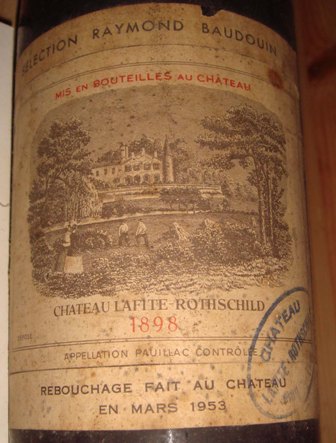
Chateau Lafite Rothschild 1898, rebouché au chateau en mars 1953
The Audouze method becomes a standard ! jeudi, 27 avril 2006
In an article on New York Times, April 25th, in the section Dining and wine, there is an article signed by Eric Asimov whose title is : « The pour ».
And he says in the middle of his article : »
The 2001 Pontet-Canet surprised me the most. I was looking forward to this wine, which I had not tasted since last spring, when it finished at the top in a Wine Panel tasting of 2001’s from the Medoc.
It was not nearly as good as I had remembered it. The aroma was young and primary, with little complexity, and it seemed hollow in the middle. It sat in my glass until Dr. S pointed out how brilliantly this wine went with the watercress salad, and he was right. Maybe it was the acidity of the wine that matched the dressing, but it also went well with the potato gateau. Maybe it just needed more air, even though we had opened the bottles hours before, pouring a little out of each bottle in an alternative to decanting sometimes called the Audouze method. »
Needless to say that I am proud ! (the method is explained in this blog).
I tried with success a Royal Kebir Algerian wine 1945 jeudi, 27 avril 2006
One day, someone asked me to make a dinner with Jacques Le Divellec one of the greatest chef for fish, and we studied what to do with my list of wine. Jacques invited me to put everything in form, and I was happy with the cooperation.
The man who ordered the dinner had a familial problem and asked me to postpone the dinner.
Time went on, and meanwhile, we created friendly relationship with Jacques.
I kept in mind the dinner which was postponed, but the wish to do something together was still there. As I had no news from the man who had ordered a dinner, I decided that one of my next dinners would be with Jacques. He wanted that we work on a new wine list that I had prepared. So I said : you have been so nice to me, if we have lunch together, I will bring wine.
We met with his wife Marguerite for a lunch for three. As I arrived just for lunch time, none of my wines had the necessary oxygen.
What did I bring? The first bottle is Frederic Lung Royal Kebir Algerian wine 1945 that I had bought recently as a cat in a bag. Perfect fill in the neck for a bottle coming from an original case that I opened myself. The cork stuck to the glass so I had to tear the cork into pieces to pull it out.
The second bottle came from a friend whom I appreciate, who is in the wine business, who asked : could you buy some of my wines as I am short of money. He proposed a La Tache 1960 with a low fill, saying : it should be good. The cork went out very easily, and the acidic smell did not hurt me.
We began with some crevettes, some amuse-bouche on a Puligny-Montrachet les Pucelles Domaine Leflaive 2000. Very drinkable, powerful, it is very pleasant, but I must say that it is more charming than elegant. No mistake, but no thrill. Then, on a plate, I had two huge belons oysters number 0000 (four times zero), which are enormous. What a taste! Amazing. And on a Besserat de Bellefon which is an average champagne, the oysters put the champagne on a trampoline. It gained some personality. The spéciales number two were nice, but not at the level of complexity of the belons.
Then I tried “violets”. I am 63 years old. It was the first time that I tried this animal. It is so ugly that the aesthetical disturbance prevented me to try it up to now. Jacques wanted to see my reaction on the violet plus champagne. It was fantastic.
We had some crude turbot, fantastic meat. The Puligny was not appropriate, too strong, but the wine of my dinner will be.
We had some sea fruits with complicated names (I have not my dictionary), like moules, palourdes, young calamars. The recipe should be changed, but it will match perfectly the Krug Clos du Mesnil that I intend to open.
Then we had two huge langoustines with foie gras, and the Royal Kebir 1945 was fantastic. This wine appears like a burnt wine. It makes you think of Port wine, of Maury, it is torrefied. But when you look behind the curtain, it is an emotional wine that you could take for a Chambertin. All in this wine is balanced. I felt liquorice in it. It is as if a Chambertin would have grown up in Lebanon. The more it developed, the more its complex structure was brilliant.
And I must say : it is strange, but it is a great wine.
We had then lamproie, which is one of the oldest fishes living in France, created some million years before our time. The meat tastes like earth, so I thought that La Tache 1960 would be great. But, I should never trust friends. I try to emphasize a wine which was largely over the hill. No hope despite some flashes.
I tried it on a cheese and at one moment I had some memories of a good La Tache.
But the final test was definitive : on a chocolate mousse, the Royal Kebir 1945 was magnificent, and the La Tache was like a lost sponge.
We have prepared the menu for a dinner to come in May (paying), and there will be in the menu three completely forbidden animals whose hunting is forbidden. Jacques, who is 73 years old, thinks that with me he can make mad things that he would never do with other people.
dîner de wine-dinners au restaurant Ledoyen jeudi, 27 avril 2006
jeudi 26 avril 2006 – 0 places disponibles Cette photo montre le soin qu’il faut apporter à l’ouverture des vins anciens. Le plaisir à table dépend aussi de ce travail minutieux.
Dîner n° 72 –
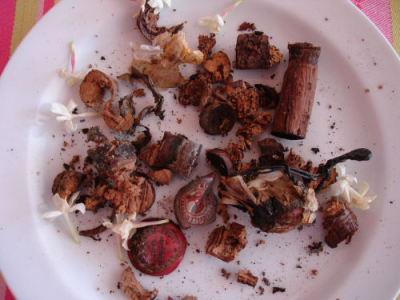
- Champagne Moncuit (Mesnil s/Oger) 1995
- Champagne Krug 1988
- Château Haut-Brion blanc 1998
- Côtes du Jura rouge Jean Bourdy 1947
- Château de Cadillac en Fronsac 1964
- Château Lafite-Rothschild 1934
- Château Haut-Bailly 1918
- Chambertin Clos de Bèze Joseph Drouhin 1949
- Château Terfort Sainte Croix du Mont 1927
- Château de Fargues 1989
sur cette assiette d’un dîner antérieur, j’ai jeté quelques parcelles de fleurs…
dîner de wine-dinners au restaurant Ledoyen mardi, 25 avril 2006
Après des repas réussis racontés dans de précédents bulletins, la tentation était grande de faire un dîner au restaurant Ledoyen. La cérémonie d’ouverture des vins s’est faite avec une facilité particulière, en un temps très court : de l’ordre d’une heure pour les dix bouteilles. Aucune mauvaise surprise. Les bouteilles de secours restèrent sur le banc de touche. L’odeur merveilleuse du Haut-Bailly 1918, de fruits rouges sucrés, était si belle que je préférai mettre un bouchon neutre pour emprisonner ce charme et éviter son déclin. Le lieu bruissait d’une folle activité car environ 500 personnes se rendaient qui à un cocktail, qui à un dîner. Le rassemblement de mes convives se fit sur le parking entouré de beaux et grands arbres, en un des plus beaux sites de Paris caressé par la bonne humeur d’un printemps qui s’affirme.
La table est dressée dans le restaurant gastronomique et Frédéric sommelier attentif, qui m’avait aidé à ouvrir les vins, a réalisé un service de très grande qualité. Le menu, mis au point avec le talentueux chef Christian Le Squer et avec le perfectionniste Patrick Simiand est d’un bel équilibre : Huîtres de Belons / Oursins de Roche en coque à l’avocat, soufflé de corail rafraîchi / Blanc de turbot de ligne juste braisé, pommes rattes truffées / Asperges vertes cuisinées dans leurs sucs truffés / Grosses langoustines bretonnes poêlées au naturel / Jambon blanc, morilles, parmesan aux spaghettis / Fourme d’Ambert / Croquant de pamplemousse cuit et cru au citron vert.
Le contingent de cadres dynamiques et motivés qui se regroupe à la table est attentif, à l’écoute des accords raffinés mais aussi enjoué, souriant, pour composer une atmosphère chaudement participative et décontractée. J’avais demandé que l’on commence par des huîtres toutes simples, mais nous recevons les délicieux petits amuse-bouche qui font danser la java à nos papilles. C’est particulièrement bon, heureusement passager, car ça ne gênera pas l’accord désiré de l’iode de belons goûteuses avec le champagne Montcuit 1995, blanc de blancs de Mesnil-sur-Oger d’une définition précise, d’une fraîcheur raffinée, et d’une expressivité plaisante. L’accord se fait fort bien.
L’oursin est d’une délicatesse rare, tout en suggestion. Il met en valeur le champagne Krug 1988 de façon éblouissante. On mesure la densité de cet immense champagne. Quel charme ! J’ai souvent bu ce 1988. Je crois que ce soir c’est le plus grand. Il a gagné en maturité. Un agréable fumé signe les champagnes épanouis. Nous nous sentons de mieux en mieux.
Le turbot à la chair lourde de sens permet au Château Haut-Brion blanc 1998 d’étaler la palette invraisemblable de sa complexité. C’est un kaléidoscope de saveurs. Et c’est la pomme de terre qui donne une longueur supplémentaire au vin blanc de grande race. Après trois accords de ce calibre, mes convives comprennent que ces emboîtements de saveurs ne sont pas l’effet du hasard. Tout ceci est voulu et fonctionne.
Le Côtes du Jura rouge Jean Bourdy 1947 est un vin très compliqué à comprendre. Aussi ai-je longuement expliqué comment l’aborder. Car si l’on a en mémoire un référentiel de bordeaux rouges, on va passer à côté du message. A mon agréable surprise, je suis bien suivi dans la découverte de ce vin qui reçoit de merveilleuses asperges vertes un étai idéal. Le vin est étonnamment jeune pour un 1947, d’un rebouchage récent à la cave Bourdy. Il est austère comme la région, brut de forme, bourru. Mais quand on a compris sa rudesse autochtone, on profite d’un vin très typé, très fruité, ascète cependant, croquant sur les asperges.
Le Château de Cadillac en Fronsadais 1964 est une découverte totale. Le nez est chaud, joyeux. Mais la bouche est un peu voilée. C’est un vin plutôt agréable qui eut même l’honneur d’un vote dans nos quartés finaux. Il va servir de faire-valoir à un Château Lafite-Rothschild 1934 particulièrement charmant. Ce vin est élégant, courtois, bien né. Bouteille au bouchage d’origine, il a un goût authentique de vrai Lafite à la longueur encourageante. Mais, convenons-en, la vedette est dans l’assiette. La langoustine juste poêlée, expression pure de ce précieux crustacé, est saisie, et dégage une émotion rare. C’est un plat dont la pureté est éblouissante. Inutile de dire que les vins s’en sont complus.
Alors qu’on avait profité des deux vins ensemble sur le plat précédent, j’ai demandé qu’on serve séparément les vins de ce plat, pour en profiter pleinement. Ce fut un bon choix. Le Château Haut-Bailly 1918 a le nez de confiture de framboise qui m’avait tant ému en ce Cros Parantoux Henri Jayer 1992 bu chez Michel Bras. On a la même sensation odorante, malgré l’écart d’âge. La couleur de ce vin est du rubis le plus exalté. En bouche, la jeunesse de ce vin sensuel éblouit. C’est assez inimaginable de voir à quel point ce Haut-Bailly explose de générosité. Il est aidé par le plat fort juste, mais il saurait se débrouiller tout seul tant il a de la force tranquille. Je rappelle juste ce que je disais de ce vin dans le bulletin n° 111 : « sur le pigeon d’un classicisme de bon aloi, on commence par le Haut-Bailly 1918. Le nez absolument exceptionnel me chavire. C’est beau, raffiné, riche, opulent, rassurant, envoûtant. Alors qu’à l’ouverture Mission 1918 avait été aussi brillant, il avait ensuite un peu faibli au service. Là, le Haut-Bailly est époustouflant de panache, d’excellence. Un immense vin aussi bien au nez qu’en bouche où il est juteux, rond, accompli, serein. Quand on atteint des niveaux de cette altitude, j’ai comme un choc. Je suis groggy de sa perfection. ». C’est assez intéressant de constater cette similitude de performance. J’en avais dit autant de bien dans le bulletin 18 il ya maintenant cinq ans. Voilà un vin éblouissant de conservation et de jeunesse.
Mais attendez un peu ! Car sur la deuxième partie du plat que nous avions tous conservée sauf un convive, le Chambertin Clos de Bèze Joseph Drouhin 1949 est le chant d’amour de la Bourgogne dans son expression la plus aboutie. Dans des villages, il y a toujours un grand panneau portant une immense carte détaillée et imagée qui vous explique pourquoi vous êtes perdu. Ce chambertin est cette carte pour expliquer le charme inouï des vins de Bourgogne. C’est pur, charmant, joyeux, coloré, expressif, sensible. Et c’est long en bouche. Je me sens bien avec des vins aussi chantants et réussis.
A l’ouverture, le Château Terfort Sainte Croix du Mont 1927 était assez discret. Au moment où on le sert, il s’est agaillardi. D’une jolie couleur de thé léger où l’on a trempé du miel, il est élégant, bien élevé, et forme avec la fourme extrêmement appropriée un accord qui nous surprend tous : il n’y a aucune rupture gustative entre le fromage et le vin qui semblent se prolonger d’une façon irréelle, comme ces patineurs qui épousent la même trace de glisse. C’est magnifiquement beau de plaisir distillé. A l’inverse, le Château de Fargues 1989 montre tout de suite ses biscotos. C’est le cousin d’Yquem, mais il ne se sent pas inférieur, et il a raison. Sauternes magique, puissant, équilibré, chaud en bouche, aux évocations infinies, il a été incroyablement magnifié par un dessert absolument parfait. Quel accord ! Toute la table était bouche bée devant cette perfection gustative.
Christian le Squer est venu nous expliquer certains de ses choix et j’ai trouvé son propos particulièrement émouvant. Je le sens animé par une volonté de perfection qui trouve une application excitante dans ce type de dîners. C’était beau qu’il vienne confier ainsi les pistes de sa recherche. Il a eu l’intelligence de simplifier des recettes pour que le vin se magnifie. Et tout a été réussi. Les accords étaient aussi beaux que de la natation synchronisée, sans aucune fausse note.
Comme chaque fois les votes furent tous différents mais avec des tendances. Neuf vins sur dix ont eu droit à un vote ce qui me plait toujours. Le Chambertin a reçu huit votes dont deux de premier, le Haut-Brion blanc a reçu sept votes dont trois de premier, le Lafite 1934 a reçu six votes dont quatre de premier, et le Terfort 1927 a reçu plus de votes que le Fargues, dont un vote de premier.
Mon vote a été le suivant :
1- Chambertin 1949,
2- Haut-Bailly 1918,
3- Lafite-Rothschild 1934,
4- Krug 1988.
Bonne humeur, service des plats absolument parfait, travail de sommellerie de Frédéric de grande précision, équilibre du menu et accords mémorables, vins au sommet de leur forme. En ce soir d’un joli printemps l’ordre était à la joie de vivre et à la gastronomie parfaite.
dîner de wine-dinners au restaurant Laurent dimanche, 23 avril 2006
L’histoire commence il y a un an quand un groupe d’américains vint visiter quelques châteaux bordelais. L’un de ces amateurs m’avait demandé d’organiser un wine-dinner pour lui et l’un de ses fils à la fin de son voyage. Il m’avait dit qu’il apporterait un magnum de Haut-Brion blanc 1949. Cette générosité appelant la réciproque j’avais ajouté au programme un vin de Chypre 1845. J’ai raconté ce dîner où figurait aussi un magnum de Pétrus 1964 dans le bulletin 145. En ce début d’année, cet ami californien m’annonce sa visite en France, et indique les vins qu’il compte apporter à un dîner wine-dinners. J’estime que tant de générosité exclut le moindre paiement. Le repas aura la structure d’un wine-dinner, et ce sera le 69ème, mais il aura une forme différente sur deux points : ce sera un repas familial, avec ses enfants et les miens, sans budget, et avec des vins apportés par nous deux.
La mise au point de la liste fut d’ailleurs amusante, chacun améliorant son apport quand l’autre ajoutait une rareté, comme en une joute amicale. Après trois ou quatre rounds le programme avait pris forme, avec des vins qui sont des témoignages de l’histoire magique du vin.
Steve, Michael, Justin et Wesley viennent visiter ma cave, avec quelques exclamations admiratives, puis nous nous rendons tous au restaurant Laurent où je vais ouvrir les bouteilles selon le rituel classique. La seule bouteille qui représente une interrogation gustative est le Pétrus 1947 au bouchon sec en haut et noir et gras en bas qui se pulvérise à l’ouverture. Le nez un peu amer doit normalement disparaître. La vraie énigme est celle du Lafite 1865. Un bandeau provenant du château indique un rebouchage en 1986. Or, en extrayant le bouchon qui reste complet, il me parait impossible qu’il soit de 1986. Il fait beaucoup plus vieux que cela. Alors, que s’est-il passé ? Le Gewurztraminer 1934 a été rebouché en 1979 et son bouchon parait d’hier. Les bouteilles au bouchon d’origine sont le Laville 1955, le Vouvray 1929, le Pétrus 1947, le Château Chalon 1864 (bouchon tout rabougri protégé par la cire craquelée) et Filhot 1929. Les vins rebouchés sont Latour 1924, sans doute dans les années 80, Lafite 1865 annoncé rebouché en 1986 et le Gewurztraminer en 1979.
Mes amis repartent se changer à leur hôtel après avoir trinqué d’un champagne Jacqueson 1996 très agréable et délicieusement frais que Patrick Lair nous a offert, pour célébrer l’ouverture de ces beaux flacons. Pensant que mes amis américains, qui ne connaissent pas les vins du Jura, pourraient commettre un contresens, je demande qu’on me prépare un Château Chalon 1976 de la carte du restaurant avec du Comté de 24 mois et du Salers que nous goûterons dans le joli jardin du restaurant car il fait très beau.
En attendant leur arrivée, ma femme et moi goûtons le dessert prévu, car la crème glacée me fait peur. Je demande qu’on sépare cette partie du dessert de la seule rhubarbe. Je sens que cela contrarie Patrick, pour l’esthétique de la présentation, mais cette décision fut la bonne.
Tout le monde est là, et le Château Chalon 1976 plait beaucoup aux américains dans l’association avec le Comté suisse. Le Salers n’a pas sa place avec ce vin. Steve m’offre une bouteille de Climens 1943 car c’est mon anniversaire. Cet ami est d’une rare générosité, comme il le fut avec les vignerons qu’il était allé visiter pendant toute la semaine.
Nous passons à table, et voici le menu intelligent, solide, chaleureux qui a été conçu par Philippe Bourguignon : cuisses de grenouilles juste rissolées, pointe de curry / araignée de mer dans ses sucs en gelée, crème de fenouil / foie gras de canard poêlé et primeurs en aigre-doux / carré d’agneau de lait des Pyrénées caramélisé, côtes de romaine, fève et morilles / épaule confite dans son jus, fleurs de courgettes croustillantes / comté 18 mois / rhubarbe cuite au naturel, sablé craquant à la cardamome et crème glacée au nougat / café mignardises et chocolat.
La forme du magnum de champagne Krug 1976 est d’une grande beauté. La couleur est d’un blanc à peine rosi, le bulle est lourde et pèse sur la langue. Les senteurs de ce champagne sont d’une impressionnante variété. Il y a du doucereux et du strict, un charme féminin presque sensuel. En bouche, le champagne s’impose par une personnalité extrême. On imagine toutes les cuisines qu’il pourrait accueillir. Magnifique expression d’un champagne parfait. La pointe de curry est d’une intelligence absolue avec ce champagne envoûtant.
Le Château Laville Haut-Brion blanc 1955 a une jolie couleur discrètement dorée. Son nez est parfait, et en bouche, c’est le blanc de Bordeaux porté à son plus haut niveau. Steve, mon ami, qui collectionne ce vin rare et en possède 43 millésimes différents, pense que cette année est plus belle que toutes les autres. Sur ce qu’on boit, je suis prêt à le croire, car c’est d’une exactitude absolue. Malheureusement, la crème qui coiffe le crabe raccourcit le vin. Il faut piocher sous la crème pour avoir un accord délicieux, la chair de l’araignée se mariant merveilleusement bien.
Je n’avais pas du tout remarqué que le Vouvray d’origine 1929 avait un nez bouchonné. Fort heureusement, il n’y a aucun soupçon de trace de bouchon au goût. Ce Vouvray discrètement doux est magnifique de complexité. On peut citer tous les fruits de toutes les latitudes du globe, et on en trouvera la trace dans ce vin. Il est subtil, adorable, magique. Avec la merveilleuse chair aérienne du foie gras, c’est un plaisir absolu. La chair prolonge le vin délicatement. C’est peut-être le plus bel accord de ce dîner.
Patrick Lair, qui aura fait ce soir un travail d’une motivation et d’une sens des nuances qui méritent les remerciements les plus vifs jouit de nous voir profiter de ces vins dans les rires, la bonne humeur et la décontraction d’amis observait l’évolution de nos plaisirs. Il nous apporta un Vouvray de 1951 aimable mais limité qui eut le mérite de montrer à quel point le 1929 était dense et complet.
Le carré d’agneau est un plat d’une solidité qui plait aux vins émouvants qui arrivent. En goûtant la première gorgée du Pétrus 1947, je suis affreusement déçu. Je demande si l’on veut que je fasse ouvrir le Pétrus 1971 que j’avais apporté à titre de sécurité. Justin et Wesley, les deux enfants de Steve disent : « on ouvre ». Je goûte à nouveau et la surprise est extrême, car le vin a instantanément ressuscité. Steve a cru que j’ai joué avec mes convives en proposant d’ouvrir le 1971, comme si je voulais les piéger, mais j’étais sincère en croyant détecter un problème qui n’existe pas. A coté du Pétrus est servi Château Latour 1924. Comment est-il possible que la couleur de ce vin soit d’un rubis aussi jeune ? C’est la couleur d’un 1986. Le vin est très Latour. Très jeune, solide, structuré complet. Mais j’ai les yeux de Chimène pour le Pétrus, d’une subtilité de ton invraisemblable. C’est son nez d’une grande discrétion qui m’envoûte par ce charme rare. Je ne retrouve pas la force habituelle de Pétrus. Mais la subtilité est telle qu’on en reste sans voix.
Sur l’épaule goûteuse, le Château Lafite 1865 mérite le respect. Lui aussi a une couleur plus jeune que celle du Pétrus, seul rouge au bouchon d’origine. Le goût est très Lafite, caractéristique de sa pureté. On boit ce vin avec la plus grande considération pour l’histoire. Ce vin est long, plein, riche comme un vin des années 40 du 20ème siècle. Comme on a les trois rouges devant soi, c’est nettement le Pétrus 1947 qui capte mon émoi. Avoir devant soi trois verres avec Latour 1924, Pétrus 1947 et Lafite 1865 ne peut en aucun cas laisser indifférent.
Je suis à peu près sûr que j’ai commis une erreur d’analyse avec le Château Chalon Clos des Logaudes 1864, le plus vieux de mes vins du Jura. J’en attendais énormément, puisqu’à l’ouverture, c’est celui qui de loin m’a le plus ému. Je suis probablement passé à côté. Et mon épouse m’a fait le reproche de l’avoir dit, ce qui influence forcément mes convives, alors que tous aimaient ce vin, mon gendre appréciant sa grande finesse. Un autre signe confirme mon contresens : Wesley, le jeune fils de Steve avait participé au dîner de l’an dernier, et au moment des votes, il avait voté strictement comme moi, ce qui est très peu fréquent. En fin de repas, je lui demande quel vin est son préféré. Et il me dit : Château Chalon. Je m’en veux doublement en écrivant ces lignes : trop d’attente et erreur de jugement. Je lui trouvais un goût de voile et de poussière. Je ne saurai pas pourquoi je ne l’ai pas aimé comme sans doute il le méritait.
La rhubarbe arrive, d’un goût exactement adapté au Gewurztraminer Sélection de Grains Nobles Hugel 1934. C’était le plus beau nez à 17 heures à l’ouverture. Là, quelques heures après, le nez est éblouissant de soleil, de tropiques. Ce vin d’Alsace est exceptionnel. Surtout, il met à l’aise par la générosité naturelle de sa palette de saveurs. Quel grand vin ! Il ne méritait que la rhubarbe et le sablé. Bel accord. J’avais déplacé ce vin jugé puissant, initialement prévu sur le foie gras, car sa force aurait tué le Vouvray. J’ai bien fait.
Le Château Filhot 1929 a une couleur plus sombre que d’autres que j’ai. Il était prévu pour être un dessert à lui tout seul, sauf si l’on voulait goûter les palmiers du restaurant Laurent qui sont les meilleurs de la planète. Mais c’est évidemment tout seul qu’il fallait apprécier ce sauternes immense. Je pense qu’il est d’une perfection absolue. Il a tout pour lui. Je ne fais jamais de comparaison en mettant deux Sauternes côte-à-côte, mais je pense que ce Filhot se situerait très haut dans la hiérarchie des sauternes de 1929.
Je n’ai pas fait voter, car il était tard et ces infatigables américains voulaient fumer un cigare au bar Hemingway du Ritz. Mon vote personnel est en faveur des blancs qui ont montré qu’ils sont clairement et naturellement parfaits, même si boire Pétrus 1947 ne se produira pas souvent, avec cette subtilité de goût et cette émotion raffinée.
J’ai ainsi choisi : 1- Filhot 1929, 2- Gewurztraminer Hugel 1934, 3- Krug 1976, 4- Vouvray 1929. Le restaurant Laurent a réalisé une cuisine dont la simplicité et la qualité technique sont l’exact accompagnement de ces grands vins. Christèle nous a servis avec compétence et Patrick Lair a organisé le déroulement de cet événement avec talent. Il nous a dit : « vous savez, il y a beaucoup d’amateurs qui auraient aimé être à votre table ». Il a bien raison. Rappelons les années, juste pour le plaisir : 1864, 1865, 1924, 1929, 1929, 1934, 1947, 1955, 1976, 1976. A mémoriser pour la vie.
